As the first generation of Nintendo gamers entered the blogging class, a wave of nostalgia followed. And it’s not entirely undeserved. There are many virtues among those pioneers: evocative 8-bit soundtracks, dense stories, and hated enemies. And most of what modern designers know about level design—or have forgotten—came from these early efforts.
Tevis Thompson’s article, “Saving Zelda,” embodies that nostalgia for early level design:
Zelda has felt like work since Ocarina, overstuffed with tasks, jobs, trials. And not just in the plodding opening sequences or all the requests by the feckless citizens of Hyrule. Even the sacrosanct Zelda dungeons, holiest of design holies, have fallen victim to this. So many things to do, so little pleasure in doing them. Dungeons suffer further in their over-reliance on environmental puzzles. Even calling them ‘puzzles’ does a disservice to all the fine puzzles in gaming. Most Zelda puzzles are tiresome and dull, but the problem isn’t just puzzle quality or lack of ingenuity; it’s using them as the structuring principle of a 30+ hour game. They determine the very flow of Link’s dungeoneering and make the whole plunge into the dark seem more like a modest exercise, a mock trial in which you needn’t break a sweat. Some claim the result is balanced, tastefully paced, well-appointed. So why do Zelda’s dungeons often feel so pedestrian and domesticated, with about the same rhythm and urgency as the music we call ‘adult contemporary’?
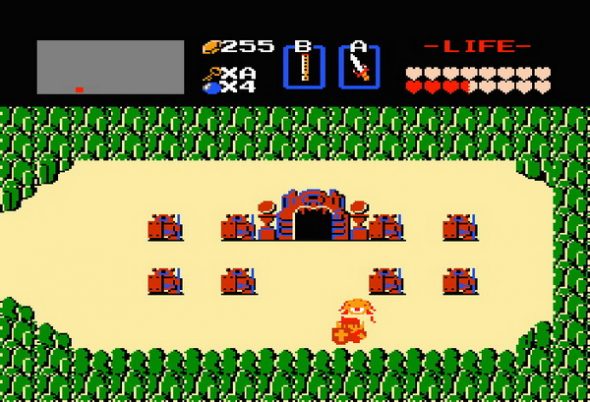
But wait, hasn’t Zelda always been like this? Aren’t puzzles somehow required by the Triforce? No, they are not. And it wasn’t always this way. The first two Zeldas had virtually no puzzles. You might have to push a block here or there, but the real test was finding your way through a maze and surviving. You had to keep track of where you were, explore every corner, and fight your ass off. In fact, mastering Link’s position on screen, in the game’s gridlike space, was key to fighting effectively. It was, and is, a surprisingly coherent, unified experience. It was, unapologetically, an action-adventure game. And a fuller, more complete experience in 1987 than anything Skyward Sword, and its magic stick, apes today.
There’s a similar though less prosaic article by Ethan Shaffer on Gaming Symmetry discussing the way level design in Metroid informs the player without having to hold their hand:
Back when Metroid was released, this combination of combat, platforming, and upgrade-based exploration was new and alien to gamers. There simply wasn’t any other game like it. The level design itself makes this apparent right from the beginning. Since the early days of gaming, whenever we are presented with a side-scrolling view, we have been conditioned to move to the right side of the screen. If you do this in Metroid, you eventually find [a dead end].
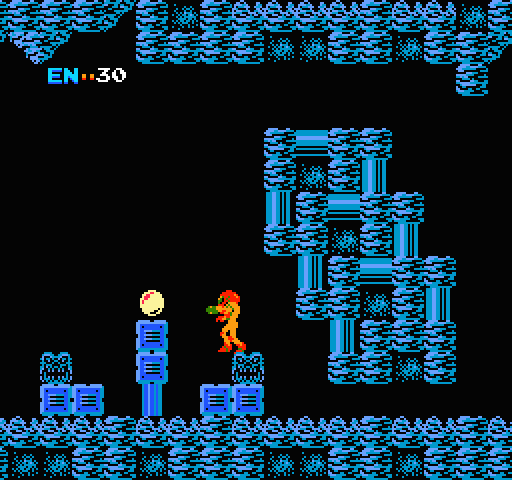
To get anywhere in Metroid, you’ll actually need to travel left from the starting screen to pick up the Morph Ball (or the Maru Mari for the purists out there). Once you have that, you can squeeze through the small opening seen in the screenshot above and continue to the rest of the game. In side-scrolling games released since, it isn’t uncommon to find secrets hidden to the left of the starting point, but there are very few games that actually require you to check behind you before charging to the right.
The design elements of these games informed the generations of games that followed. The best games on the market today take these elements to heart, letting players discover how the world works through interaction rather than rote instruction. The worst of these games walk the player through countless tutorials – or, worse, assign a helper.
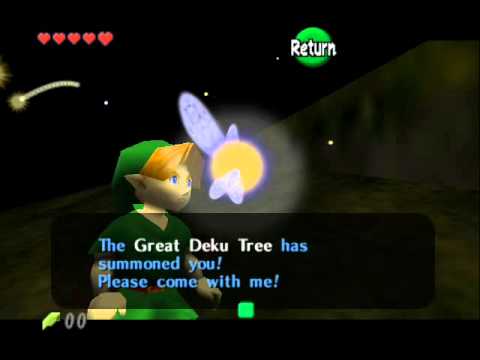
Given how annoying some of these helpers can be, it’s tempting to say that the earlier games had it right. Throw the player into a wide open world with nothing but the manual and a willingness to experiment, and let them figure it out. Thompson, in “Saving Zelda,” makes that argument explicitly:
The apocryphal tale of [Miyamoto’s] boyhood discovery of secret caves makes perfect sense when you play the original Zelda. That spirit of wonder, of potential secrets on every screen, permeated the map (and even the instruction booklet – it discreetly placed hints on the bottom of the page, inviting the player to pay attention because the hidden was everywhere). The rules of Hyrule were not at all clear to its first visitors, and one of the greatest pleasures came in intuiting the underlying logic (one secret per overworld screen, but almost one on every screen). The very existence of a second quest that remixed all the dungeons and all the secrets spoke of a world that was open and supple. The magic of the first Zelda was not locked down, given to a single iteration. It was its own sequel. It seemed like it could go on forever.
There’s a lot to be said for backing away from the chained, scripted nature of modern game worlds. And there are many virtues of the earliest Nintendo games that modern games would do well to remember. But I think that writers who pine nostalgically for the Nintendo generation – Thompson and Shaffer aren’t alone; I’m using them as stand-ins – have forgotten that these games were impossible.
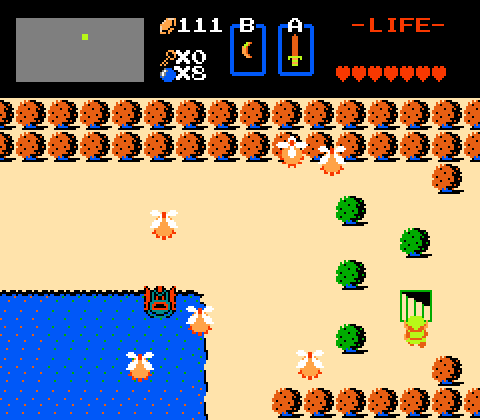
There are stairs here, because of course there are.
Not literally impossible; you could beat them. But you needed the relevant issue of Nintendo Power, or one of the third-party clue books that sprang up as a cottage industry in the late 80s, or a cousin or a neighbor who had either and was willing to share his wisdom. Without that, you were fumbling through a world of nigh-identical shrubs, throwing your decreasing stock of bombs at rock walls, waiting for a random square of pixels to show mercy and yield its secrets.
Sure, as an 8-year-old, you could intuit through pure Kantian reason that “THERE ARE SECRETS WHERE FAIRIES DON’T LIVE” means:
- Find a pond without a fairy floating over it (as opposed to everywhere else a fairy might not be);
- Play your whistle;
- Avoid the tornado that arrives;
- Voila! A dungeon!
To say nothing of the monster that blocks one passage in Level 7, which can not be killed and offers no clues to how to overcome it.
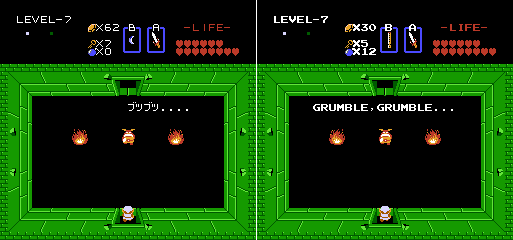
The correct answer: give it food. Obviously!
Metroid was little better. Metroid teaches you that some floors or dead-ends will yield a secret passage if bombed. But there’s no intuitive way to guess that some of the lava is actually fake lava, which you can safely roll through to uncover new passages. You can’t reach Kraid, one of the game’s three bosses, until you abandon all reason and fling yourself into a fiery pit – or unless a friend lets you in on the secret.
Now, if Thompson and Shaffer insist they beat these games without a Nintendo Power subscription, or a cousin whom they only tolerated for their Rygar insights, I won’t call them liars. Maybe they had the 40+ hours to invest in burning every shrub in the Overworld, or bombing every corner of Zebes, to uncover all of a game’s poorly translated secrets. These problems will yield to brute force.
But not all of us were so lucky. Some of us had parents who insisted we spend at least a little time outside. They got worried if we invested more than ninety consecutive minutes in Nintendo. And if we weren’t playing outside, then some of us should probably have been doing homework, or working on our extracurriculars, because how else would we stand out from the increasingly competitive cohort of college applicants without a good CV, and how do we expect to get a prestigious career in fields that don’t even exist yet, like blogging?
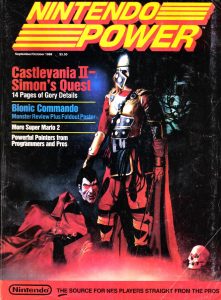
Pravda means Truth.
So let’s talk a little about “impossible” games.
I’m not the first to say this, but video games are a different creature than most other types of games. The only other sorts of games meant to reward solo play are solitaire or puzzles – logic games, number puzzles, brain teasers, and the other dying breeds of the numerate set. For most of human history, a “game” was something you played with and against someone else. A hundred years ago, Nintendo made playing cards, not Mario Kart sequels.
You can’t “beat” a two-person game the same way you “beat” Legend of Zelda. You can only beat the other player. You play to or just above their level of skill. If the game is well-designed, it’ll keep competitors in the running for as long as possible, to minimize frustration and maximize tension. But beyond that, it’s down to some combination of skill and luck between the players.
And yet, the more strategy is involved, the easier it is to approach a dominant solution. For most 20th Century households, Monopoly was an exercise in ambition and tedium. But a few hardcore devotees know the way to play to maximize your chances of winning. And it’s not complicated: it’s possible to come up with a winning Monopoly strategy that fits on an index card: aim for monopolies on the first two sides, buy up houses but not too many, orange beats light blue beats light purple, stock up on railroads.
So it’s possible to come up with a strategy that drains most of the tension from Monopoly, reducing it to a two-person exercise in probability. It’s not quite “beating” the game but it’s close. You’ve exhausted every avenue. Almost nothing in the game can surprise you anymore. You’ve reached the end.
This isn’t the normal way to play a boardgame. But it’s the expected way to play a video game.
There’s an expectation in video game design, culture, and language that you’ll play a (single player) game until it bores you or until you reach the end credits. If you get stuck – if you reach a point where the game is no longer rewarding or diverting – you’ll power through or brainstorm a way around. Your level of involvement rises as the game progresses.
Some of this is doubtless a holdover from the earliest days of arcade games, where the programming had to increase in difficulty to finagle more quarters out of you. And there’s likely some Pavlovian behavioral science that I’m too lazy to Google, where rewards need to be gated behind increasingly thorny risks to keep paying off.
But the point of a video game isn’t merely that you beat it. The point is that you feel rewarded in beating it. If all you want is the accomplishment as a checkmark, you might as well play Burn The Rope.
The beauty of the Nintendo generation of single player games is that they allowed multiple levels of engagement. You could beat The Legend of Zelda through stubborn trial-and-error, as some hardcore gamers apparently did. You could beat it with the assistance of tips and guides, which bypassed much of the frustration but didn’t save you from hordes of predictable yet deadly monsters. And even after you’ve beat it, you can try beating it with handicaps: never getting the red armor, never increasing your heart containers, or never picking up a sword. And there’s a whole Second Quest hidden beneath the first!
Modern single-player video games have embraced that direction as best they can. The ubiquity of sandbox games means players have to set their own agenda: completing the main storyline, racking up accomplishments, visiting every corner of the world, or stacking an improbable number of objects atop other objects. They may not be particularly challenging for hardcore gamers, but they leave room enough to set your own challenges.
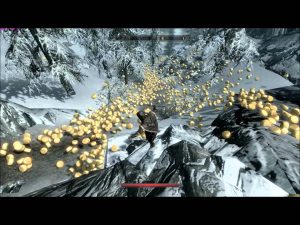
Skyrim. Cheese wheels.
If the fun of a video game comes from beating it, then maybe we keep the threshold for beating it within reach. Not every game needs to be “Nintendo hard” – that colloquial benchmark of chair-breaking frustration; the Marsh Cave in Final Fantasy, the Turbo Tunnel in Battletoads, any level with birds in Ninja Gaiden. Players who want additional challenges can beat the game on a speedrun, or without upgrading their weapon, or playing with the controller upside down. But players who want the satisfaction of achievement shouldn’t need to spend sixty hours scraping along random walls looking for clues.
I grew up on the Nintendo generation of consoles. I remember those games fondly. But I can’t pretend that game design hasn’t improved since then.
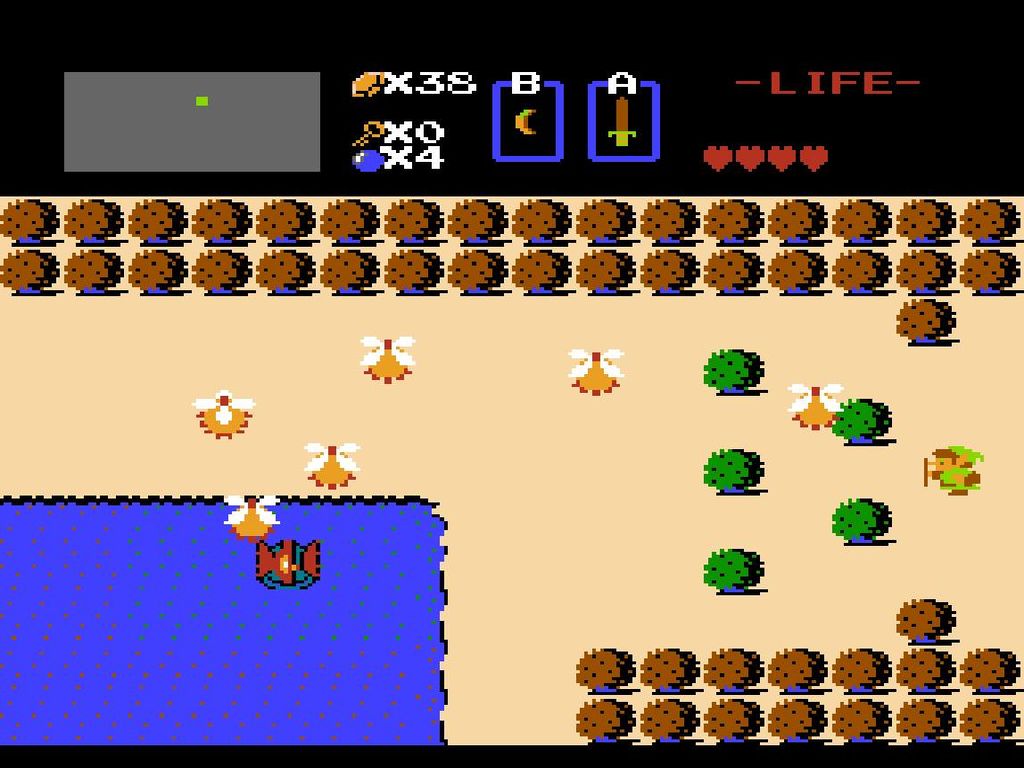
I finished this article and was a little confused.
Are you advocating for a “right” way to play video games, or just offering various alternatives that can all function as equally right ways to play?
I also read this as a critique of video game writers who hold up games from the NES generation as the pinnacle of game quality. Is that what you were going for?
My personal favorite game of all time is Metal Gear Solid on PSone. I love it because it offered a completely different experience to play the second time through **SPOILER ALERT** if you failed at torture, failed to save Meryl, and Otacon gave you the stealth camo. Running through a stealth game without having to be stealthy was amazing fun.
It also is an older game, and trying to play it now is way less fun than I remember from when I was 14. Nostalgia does weird things to our brains. It is hard to be academically critical about things we feel nostalgia for. I do appreciate anyone who can though, so thank you John Perich.